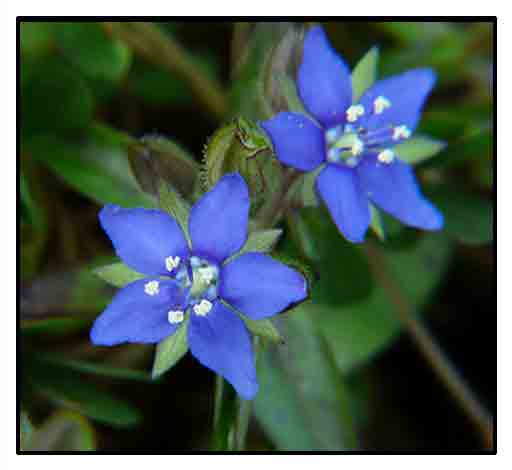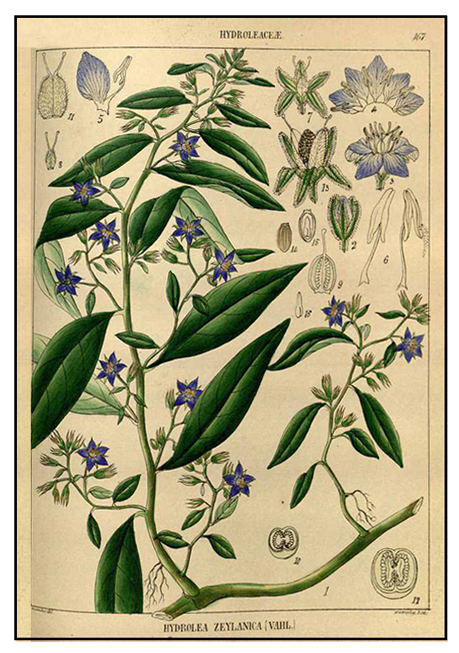
Family • Hydrophyllaceae
Ceylon hydrolea
Hydrolea zeylanica (Linn.) Vahl
BLUE WATER LEAF
Tian ji ma
| Scientific names | Common names |
| Beloanthera oppositifolia Hassk. | Ceylon hydrolea (Engl.) |
| Hydrolea arayatensis Blanco | Blue water leaf (Engl.) |
| Hydrolea ceilonica F.Muell. | Water olive (Engl.) |
| Hydrolea inermis Loureiro | |
| Hydrolea javanica Blume | |
| Hydrolea zeylanica (Linn.) Vahl. | |
| Nama zeylanca Linn. | |
| Steris aquatica Burm. f. | |
| Steris javana L. | |
| Steris javanica L. | |
Hydrolea zeylanica (L.) Vahl is an accepted name. The Plant List |
|
| Other vernacular names |
| BENGALI: Isa-langulia, Kasschra. |
| CHINESE: Tian ji ma. |
| HINDI: Koliary, Langali. |
| MALAYALAM: Cheruvallel. |
| MANIPURI: Charang. |
| MARATHI: Popti, Keriti. |
| SANSKRIT: Langali. |
| TAMIL: Vellel |
Distribution Studies Availability |
Updated October 2018 / January 2014
 |
| IMAGE SOURCE: / Flower close-up / Hydrolea zeylanica / Dinesh Valke / November 1, 2008 / Creative Commons: Attribution-NonCommercial-ShareAlike 2.0 Generic / click on image to go to source page / flickr |
| OTHER IMAGE SOURCE: / Illustration /Hydrolea zeylanica (L.) Vahl / Wight, R., Illustrations of Indian botany, vol. 2: t. 167 (1850) [Goovindo] / Illustration contributed by the Missouri Botanical Garden, U.S.A. / PlantIllustrations.org |
| Additional
Sources and Suggested Readings (1) Some Anti-Diabetic Plants of Southern Assam / G Banik, M Bawari et al / Assam University Journal of Science & Technology : Biological and Environmental Sciences Vol. 5 Number I 114-119, 2010 (2) Ceylon Hydrolea / Common names / Flowers of India (3) Content and distribution of flavonoids among 91 edible plant species / Ray-Yu Yang PhD, Shou Lin BSc and George Kuo PhD / Asia Pac J Clin Nutr 2008;17(S1):275-279 (4) Antioxidant and Antiulcer Potential of Hydrolea Zeylanica (L.) Vahl against Gastric Ulcers in Rats / Atish Kumar Sahoo and Satish Kumar / International Journal of Complementary & Alternative Medicine, 2017; Vol 10, Issue 1 / DOI: 10.15406/ijcam.2017.10.00324 (5) Exploring the in-vitro anthelmintic potential of Hydrolea zeylanica -An aquatic medicinal herb / Mohammad Shamim Qureshi, Shiv Kumar, A. Venkateshwar Reddy / Research Journal of Pharmacy and Technology, Jan 2015; 8(12) / DOI: 10.5958/0974-360X.2015.00296.6 (6) Hepatoprotective activity of Hydrolea zeylanica leaf extract on liver damage caused by carbon tetrachloride in rats / Mohammad Shamim Qureshi, A. Venkateshwar Reddy, G. S. Kumar, Jiitendra Patel / International Journal of ChemTech Research, 2017; 10(9): pp 260-266 (7) Protective Effect of Hydrolea zeylanica Vahl. Leaf extract in Ethanol and Cold Restraint Stress Induced Ulcers in Rats / Mohammad Shamim Qureshi, A. Venkateshwar Reddy, G.S. Kumar / Research Journal of Pharmacy and Technology, 2017; Vol 19, No 1 (8) CHEMICAL COMPOSITION AND WOUND HEALING ACTIVITY OF METHANOLIC LEAF EXTRACT OF HYDROLEA ZEYLANICA VAHL. BY IN VIVO EXCISION AND INCISION MODELS / Mohammad Shamim Qureshi / IJGP, 2017; 11(2) (9) ANTIDIABETIC EFFECT EVALUATION AND CHARACTERIZATION OF BIOACTIVE COMPOUNDS ISOLATED FROM HYDROLEA ZEYLANICA / Borkar Vijay S, Senthil Kumaran K, Senthil Kumar KL, Gangurde Hemant H, Chordiya Mayur A / Indonesian Journal of Pharmacy, 2015; Vol 26, No 4 (10) Hydrolea zeylanica / Synonyms /The Plant List (11) STUDY OF AQUATIC MEDICINAL PLANTS OF HAZARIBAG DISTRICT OF JHARKHAND, INDIA / Lal Hari Shankar and Mishra PK / International Research Journal of Pharmacy, IRJP, 2012; 3 (4) (12) HYDROLEA ZEYLANICA Vahl. / Medicinal Plants of Bangladesh (13) Tribal Formulations for Treatment of Pain: A Study of the Bede Community Traditional Medicinal Practitioners of Porabari Village in Dhaka District, Bangladesh / Syeda Seraj, Farhana Israt Jahan, Anita Rani Chowdhury, et al / Afr. J. Tradit Complement Altern Med., 2013; 10(1): pp 26–34 / PMCID: PMC3746354 |
• |
 |

 Botany
Botany Constituents
Constituents